Holiday friendship and wine
Posted on January 13, 2020
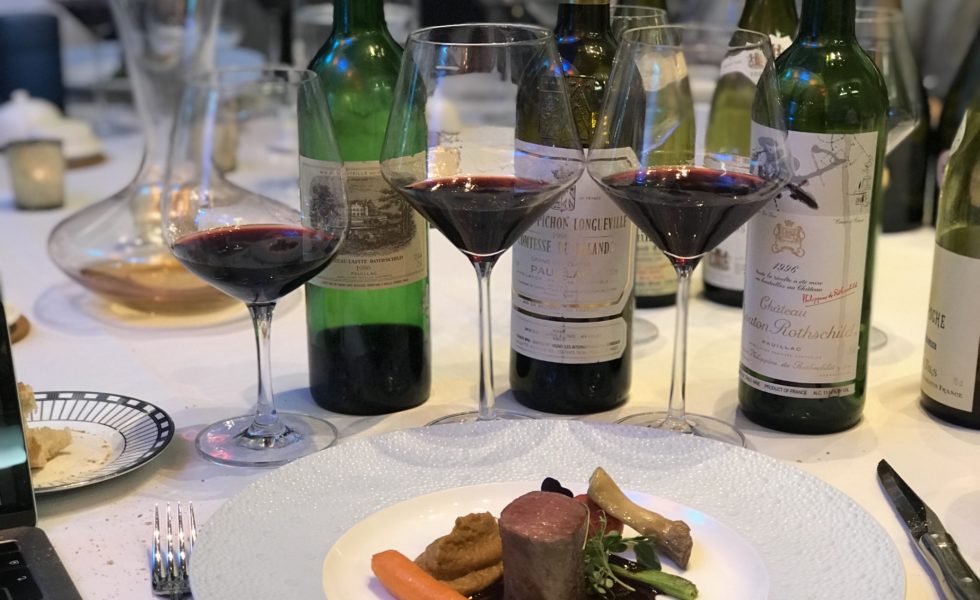
From grand cru Burgundy, to top Bordeaux and exquisite Champagne, I may have had enough wine for 2020 😉
By Panos Kakaviatos for wine-chronicles.com
13 January 2020
Once a year, old friends gather for a final holidays feast with excellent wines, and this year’s gathering was no exception.
Ken Brown coordinated this year’s dinner at the French Embassy restaurant Petit Bouchon with David Zimmerman, Howard Cooper, Karl Kellar, Kenneth Barr, Scot Hasselman, Randy McFarlane, Christopher Bublitz, Paul Marquardt, Charles Stewart and me.
In the absence of master chef Mark Courseille, his team pulled off a fine series of dishes to go with the many fine wines – nearly 30! – that we enjoyed starting at around 6 pm and ending some five hours later. As per usual, wines in bold I liked in particular. If red and bold, even more. When underlined, too, a kind of wine nirvana.
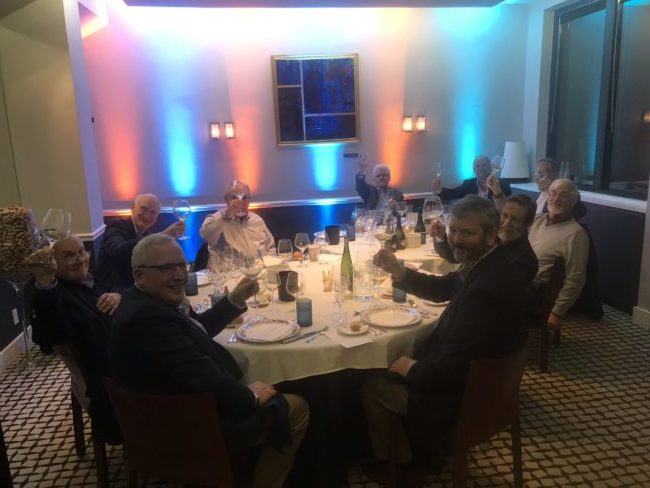
Happy crew indeed 😊
Part One
We were off to a rock em, sock em start with a foursome of excellent to superb Champagnes. Could it get any better?
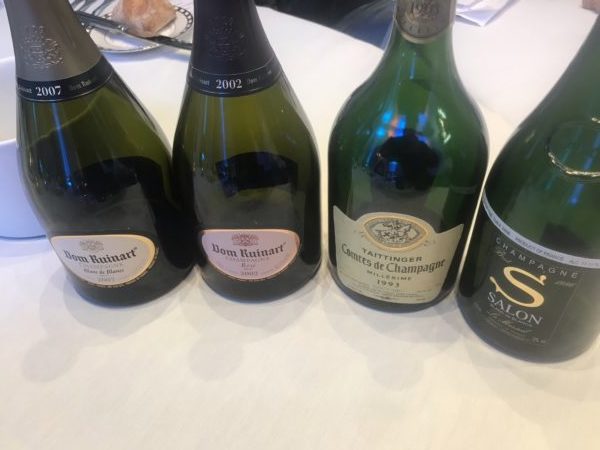
The 2007 Dom Ruinart Blanc de Blancs, which I tried last month and liked so much to do a video came across nicely coiled in as a young vintage Champagne would, but full bodied, too, displaying fine ripe pear finesse echoed in the finesse of the bubbles. The finish was marked by lime and wet stone, leaving me with the overall impression of a most smooth and elegant white Burgundy with les bulles. For lovers of tertiary notes in the Champagne, stash this away for a few more years and it will gain in complexity. 94/100
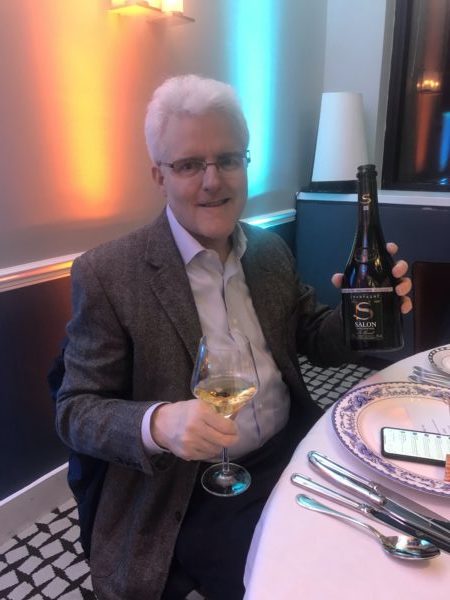
David with the wine of the night. At least one of the top three wines of the night: Salon 1996
Then came the exceptional 2002 Dom Ruinart Rosé Champagne. I saw several of us reach for the bottle a second (or third) time, and the wine was gone fairly quickly. With reason. At once beautifully crisp and full-bodied, “like a super elegant rosé”, Ken Brown commented. The wine blends 80% Grand Cru Chardonnay, 72% from the Côte des Blancs (Avize, Cramant, Le Mesnil-sur-Oger) and 28% from the Montagne de Reims (Puisieulx, Sillery) and 20% Pinot Noir made into red wine, from the Silvery and Verzenay crus. It did 100% malolactic fermentation and has a dosage of 5.5 g/l. Superb balance that demands gastronomic foods. Easily a wine for grilled salmon, roast chicken, even veal. 98/100
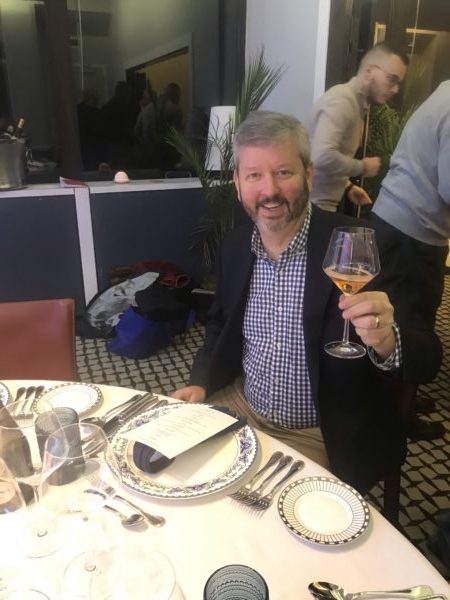
Ken Brown with the superb Dom Ruinart Rosé 2002
The third bubbly was the 1993 Taittinger Comtes de Champagne. Notes of hazelnut and toffee. Salted almond. This is pretty taut and lovely for its age. Indeed, the color is excellent, too. An overall impression of being svelte. Paul who brought it said that they had “a good run” in early 1990s, even if the 1993 vintage is not recognized as being that great. Indeed, both Decanter and wine critic John Gilman loved this in rather recent tastings. Rated 97 points by Decanter in a 2017 tasting, the panel noted that 1993 may be an average vintage overall for the region, but this 1993 proved a “real beauty, equal to the 1995 but in a different style.” Gilman gave it 94 out of 100, when he tasted it in 2016. He described the wine as having been “fully mature for many years now, but continues to be fresh and lively on the palate, with its internal structure sound and seamless.” 95/100
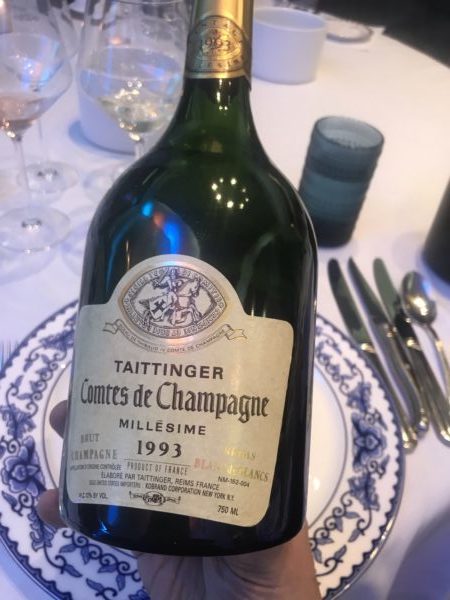
And then came one of the wines of the night and for me the wine of the night. Thank you David for bring the now rather legendary 1996 Salon Blanc de Blancs Le Mesnil*. So laser like, with focus but still tasting like a baby! At the same time a pleasing creaminess, like a super high end, home made French butter, finishing with zest and lift, candied red apple freshness. The finish lasted for something like a minute. As we sipped through it (it was gone also rather quickly), the finesse and depth became more evident with just a tiny suggestion of hazelnut to show its age, but really just a smidgeon. “Such precision and laser focus, but bursting with flavor,” remarked Chris. Indeed. 100/100. Read More
Ode to Châteauneuf-du-Pape
Posted on December 28, 2019

It’s only rock and roll, but I like it.
by Panos Kakaviatos for wine-chronicles.com
28 December 2019
The bottles seemed endless. Fifteen producers had delivered three bottles for a dinner I had organized at the restaurant of the French embassy in Washington D.C. earlier this month. But the restaurant staff received 180 bottles of wine (the delivery was 45 different wines, but four bottles each), and along with the help of star sommelier Maria Denton and Châteauneuf-du-Pape representative Marie-Clémentine Savey, we tasted through most of these bottles to avoid any cork taint issues.
Fifteen whites and 30 reds were featured at a magnificent dinner earlier this month that proved a metaphor for the generosity that is Châteauneuf-du-Pape.
At their best, the reds also convey complexity and length. And, dear readers, tis’ the season! 🎅🏻
Red Châteauneuf-du-Pape is a great drink to enjoy in the winter, especially with venison and other flavorful meat. But the wines can be paired in more creative ways, as I experienced over the 45-wine dinner held at the Petit Bouchon in the French Embassy in Washington D.C. Vintages reached back to 1986, but most of the wines were in the 2000s. Read More
Ode to Dom Ruinart
Posted on December 23, 2019

290 years old and going strong
By Panos Kakaviatos at wine-chronicles.com
23 December 2019
Ever since dear wine loving pal Randall McFarlane organized an exciting vertical of Domaine Ruinart – here an older text about that – I discovered just how amazing the wines from this Champagne house can be. After tasting the 1996 for example, and the downright exciting 1979 rosé from magnum, I have been hooked to this estate.
It helps that Frederic Panaïotis is a great fellow and talented winemaker. And that the oldest Champagne house, established in 1729, includes some of the most impressive underground cellars you can imagine visiting. To wander into the chalk quarries that act as Maison Ruinart’s cellars amounts indeed to discovering the “beating heart of the Champagne region and its wines,” as the Dom Ruinart proclaims. Any visit to Champagne should include a visit here.
Like many Champagne houses, Dom Ruinart has several brands. My overall favorite? You guessed it: their Blanc de Blancs Vintage. Made entirely of Chardonnay grand cru from the Côte des Blancs and the Montagne de Reims vineyards, these prestige wines age slowly, an average of ten years, and increase in aromatic complexity over time.
Challenging Vintage
2007 was a challenging vintage, as a warm and humid autumn led to some rot, although observers like Jancis Robinson say that Chardonnays were better than either of the Pinots. If this is the case, well good news here as we are dealing with a 100% Chardonnay wine that achieves lovely balance with 8.6 grams of acidity per liter and 5 grams per liter of residual sugar. Due to a difficult a growing season, less houses than average declared this vintage, but top producers like Dom Ruinart did well. Fermentation was completed in stainless steel vats, followed by malolactic fermentation.
How does it taste? It has such a classy profile, smooth, full bodied, yet bright. Aromas reveal those fine chalk aspects from excellent Champagne, with flint and oyster shell. With also get brioche, lime, acacia, and yellow to green citrus aspects, for example some yuzu. The palate is sap-driven and slightly creamy, yet chiseled, with more bright citrus and wet stone on the finish. Indeed the producers talk of 2007 as revealing “all the purity” of the great Chardonnays. Makes sense to me. And a fine choice take off in 2020. 😊
Portugal’s underrated dry wines
Posted on December 2, 2019

Fine (and inexpensive) : both red and white
2 December 2019
By Panos Kakaviatos for wine-chronicles.com
Lunching late last month at the upscale JNcQUOI in Lisbon cost a friend and myself €155 not including tip, but the restaurant’s bustling French brasserie style ambiance with elegant furnishing and décor, matched by superb dining options, make this two-year old restaurant worthy of at least one Michelin star.
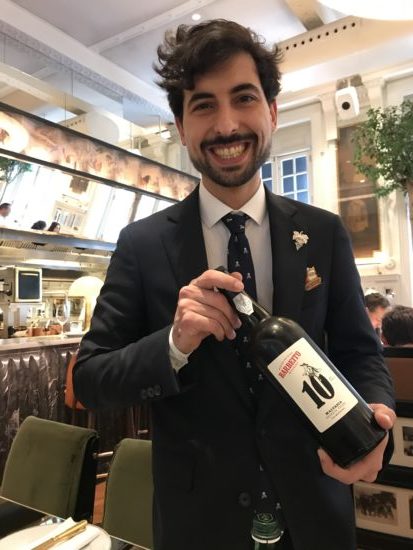
Some 1,000 references, 600 Portuguese : sommelier Diogo Yebra
The wine list counts an impressive 1,000 references, including such global and rare celebrities as Pétrus and DRC, Sine Quoi Non and Sassicaia. But 600 of them are more affordable Portuguese wines, proving yet again how delicious dry reds and whites can be from this great Old World wine producing country.
A case in point is the Antonio Maçanita Palpite Reserva 2018 vintage white of Alentejano. Palpite means “feeling”, as in I’ve got a feeling it will rain tonight, but I had more than a feeling that this wine is great, and not just because sommelier Diogo Yebra calls it “my favorite dry white of Portugal”.
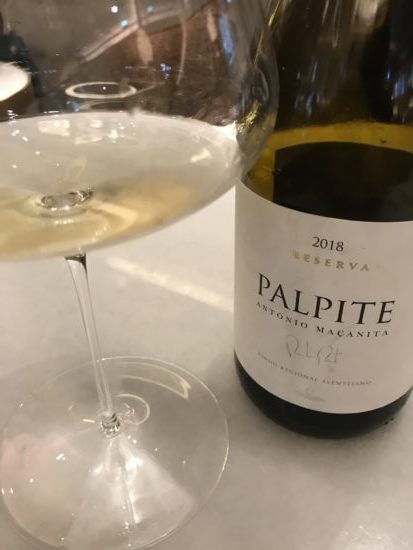
Love this white!
The brisk salinity and elegant pear skin notes, with a touch of clove, perhaps coming from the 30% new oak aging during 12 months, excite the taster. It also has a smooth, yet contoured texture, perhaps more than just medium-bodied. One gets a sense of premier cru Chablis from a ripe vintage, and a hint of more oak-driven Meursault, although there is no Chardonnay in the blend of this €28 per bottle (retail cost) field blend of 70% Arinto (known for its lemony and wet stone like aspects), 13% Tamarez, 7% Alicante Branco and 5% each of Antao Vaz and Verderlho. Read More
Ode to France, Les Accabailles and Les Crus Classés de Graves
Posted on November 21, 2019
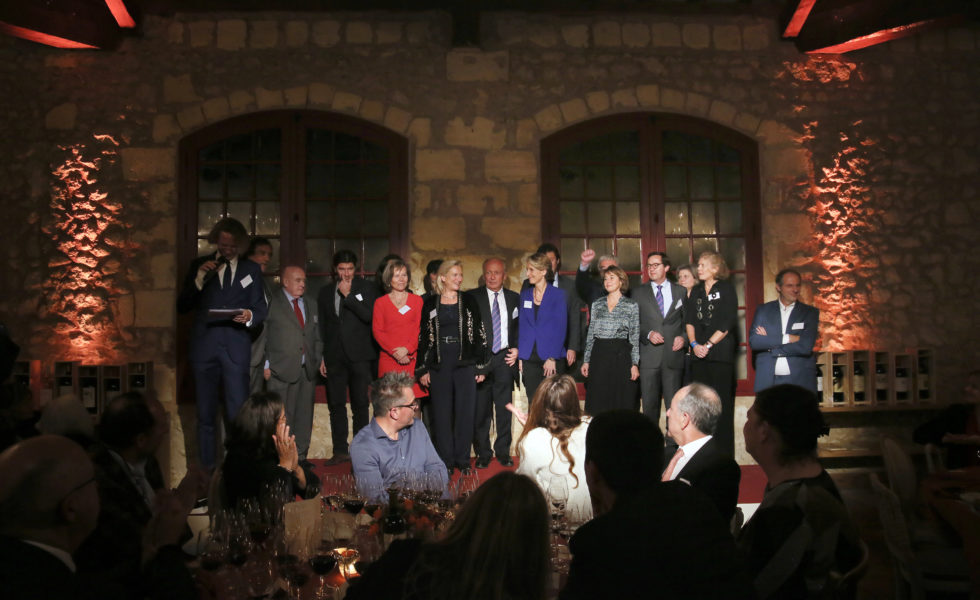
Tasting dinner of top Pessac-Léognan wines at Château Carbonnieux
By Panos Kakaviatos for wine-chronicles.com
21 November 2019
A round-trip on the high-speed train TGV traversing France from Strasbourg to Bordeaux and back took less than 6 hours. No stop in Paris. Comfy, first class seat at €170: Convenient, efficient and greener than flying or driving. I visited friend and wine author Jane Anson, who is about to publish a massive tome on Bordeaux wines. She and her husband Francis live in Bordeaux, a city that Alain Juppé has made most beautiful during his tenure as mayor. And then? A wonderful dinner on 11 November this year at Château Carbonnieux to mark the 2019 harvest in a fête known as “Les Accabailles”.
Each year, the 14 châteaux classified as Crus Classés de Graves take turns to host the event. Château Carbonnieux organized the 11 November evening this year featuring the cuisine of two-star Michelin chef Hélène Darroze. Jean-Jacques Bonnie of Château Malartic Lagravière, and president of the Crus Classés de Graves, joined Eric Perrin of Château Carbonnieux to moderate ceremonies throughout the dinner, attended by some 200 people.
Classified “great growths” in 1953 (and in 1959), the top estate is Château Haut-Brion, which had been earlier classified as “First Growth” in 1855, the only non-Médoc red wine included in that classification. Since 1987, they are categorized as Pessac-Léognan appellation wines, a distinction for what is considered superior terroir in the northern part of the Graves region, which takes its name from its stony terroir. Recognized for their superior quality as far back as the 17th century, these top Graves all have rich histories, as exemplified by the host château.
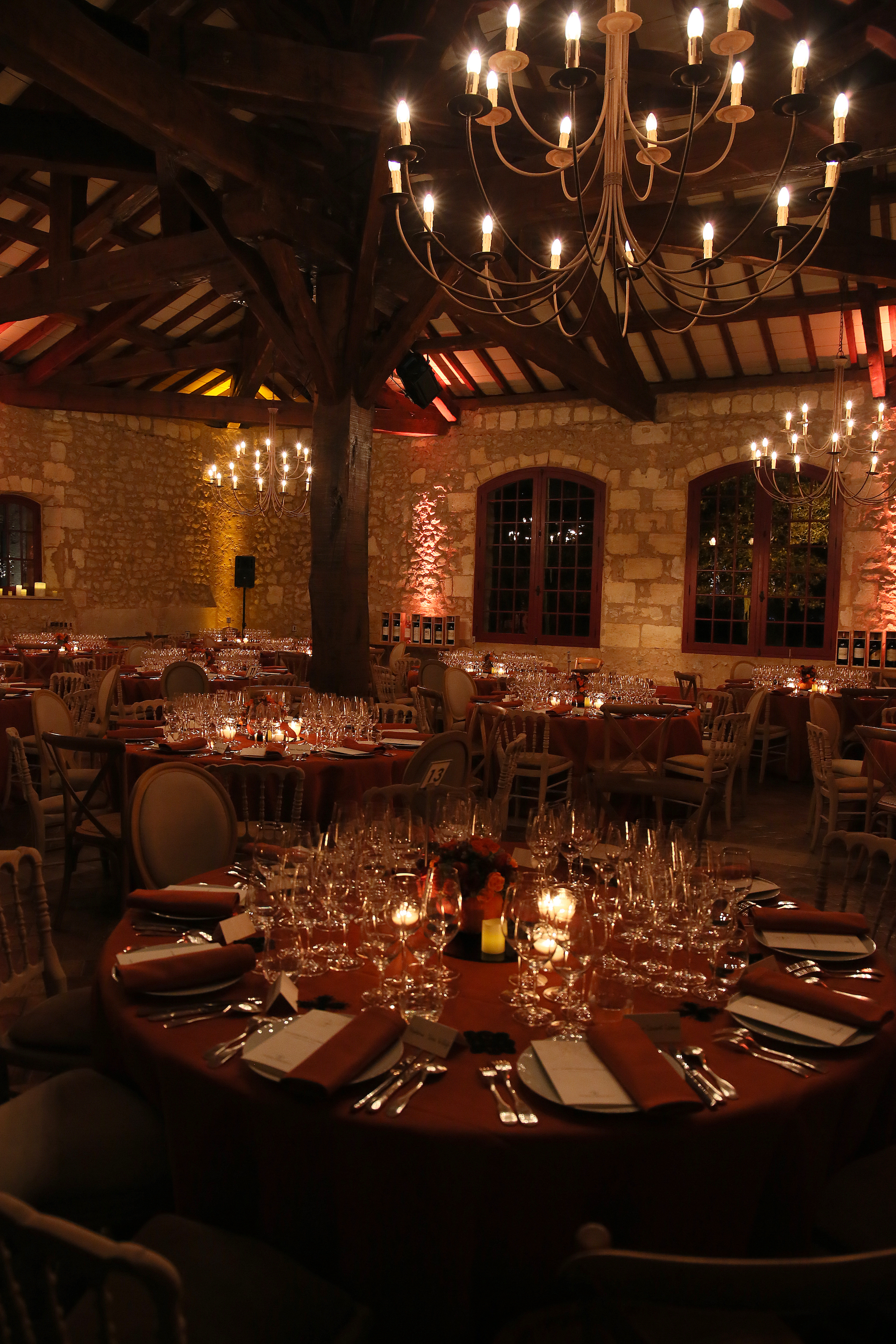
Gorgeous dinner setting at Château Carbonnieux (Credit: l’Atelier de Style)
About Château Carbonnieux
Like so many other estates in Bordeaux, this one boasts a lovely castle, tracing its history back to the Middle Ages, as the name Carbonnieux is said to come from a family called “Carbonius” or Carbonnieu, who cleared and cultivated land near Léognan at the beginning of the 13th century.
The region has experienced many ups and downs, from ruined harvests and epidemics to peak historical periods.
The Jefferson Tree
Soon to be President Thomas Jefferson, a gastronome and great wine lover, went on a grand tour of France to discover its vineyards. In 1786, he selected a few famous estates and his diary shows that he came to Carbonnieux to taste the “Wine of the Odalisques” as it was then called in the United States.
Jefferson left his mark at the estate by planting an American pecan tree on the grounds of the château. Over two centuries old, the tree still takes pride of place in the estate’s inner courtyard today. Read More
 Wine Chronicles
Wine Chronicles
Recent Comments